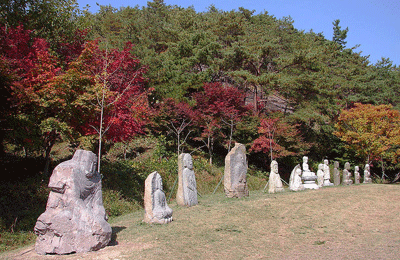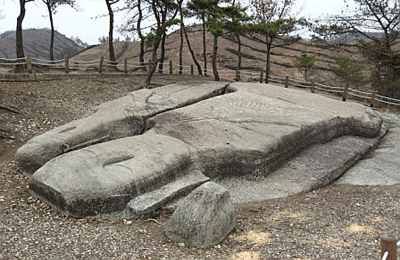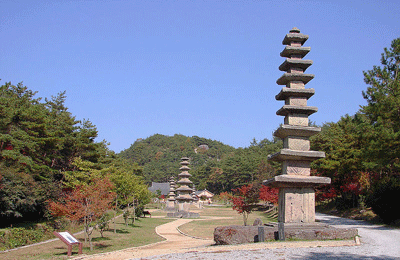Unjusa is a Korean Buddhist temple located in Hwasun County, South Jeolla province, South Korea. It is 26 km southwest of Hwasun County or 40 km south of Gwangju. Compared with other temples in South Korea, this temple has an unusual collection of stone Buddha statues and stone pagodas, so Unjusa is often referred to as the mysterious temple. Among several assumptions regarding its origin, the most widely known one is that Monk Doseon founded the temple based on geomancy during the late period of Silla Dynasty (57 BC – 935 AD), but the origins remain unverified.
Unjusa is designated as Treasure #312 and is the site of the well known Treasure #796, Unjusa Gucheung Seaktap (Nine-story Stone Pagoda at Unjusa).
Four excavations and two academic studies occurred at the temple, conducted by Jeonnam National University Museum from 1984 to 1991, but the exact time the temple was built, by whom, and construction methods remains a mystery.
Legend has it that according to the traditional theory of Korean geomancy, the peninsula was thought to be unbalanced and in danger of capsizing because there were fewer mountains in Honam, the southwestern part of the peninsula, than in Yeongnam, in the southeastern part. To prevent this disaster, one night Monk Doseon called stone masons down from heaven to build a thousand Buddha statues and pagodas at Unjusa, in the southwestern part of the peninsula.
However before the last Buddha statues could be completed, the cock crowed recalling the stone masons back to heaven just before the crack of dawn, leaving two statues laying unfinished on the ground. These two unfinished statues became known as “Wabul” or The Stone Statues of the Lying Buddha.
A more practical explanation is that Unjusa was created as a school for stone masons.
Unjusa is known for being as the only Korean Buddhist temple to ever have had over a thousand stone Buddha statues and stone pagodas, as documented in the 1432 text Dongguk Yeoji Seungram. All the statues are thought to have remained intact until at least the early Joseon Dynasty (1392 – 1910).
Presently only 91 stone Buddha statues and 21 stone pagodas still remain. The 21 stone pagodas that are scattered in the surrounding fields and mountains vary in shape and are 3,5,7 and 9 stories in height. The square pagodas are narrow and tall with flat roof stones, typical features of pagodas from the Goryeo Dynasty (918-1392). It is of special note that geometrical patterns like X and III are carved on the surfaces of the pagodas. These are the most common techniques frequently observed among the remaining pagodas of Unjusa, along with the geometric wrinkle patterns of the stone Buddha statue’s garments.
The remaining Buddha statues scattered throughout the fields around, and on the grounds of, Unjusa vary in size from dozens of centimeters/inches to more than 10m/33ft high. The statues all have similar features unique to Unjusa having pillar-like bodies, simple faces, arms and hands that are out of proportion with the rest of the figures, wearing clumsy drapes of plain Buddhist robes – features that are similar to localized features of stone Buddha statues of the Goryeo period.
Unjusa enshrines many special stone statues of Buddha presenting good examples of religious symbols, supporting the belief that the existence of these stone Buddhas and stone pagodas will greatly enhance the research of Buddhist art history in Korea.
Tel: +82-61-374-0660
Web: www.unjusa.org
(From: wikipedia)







